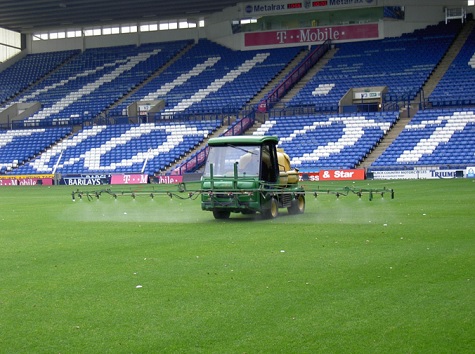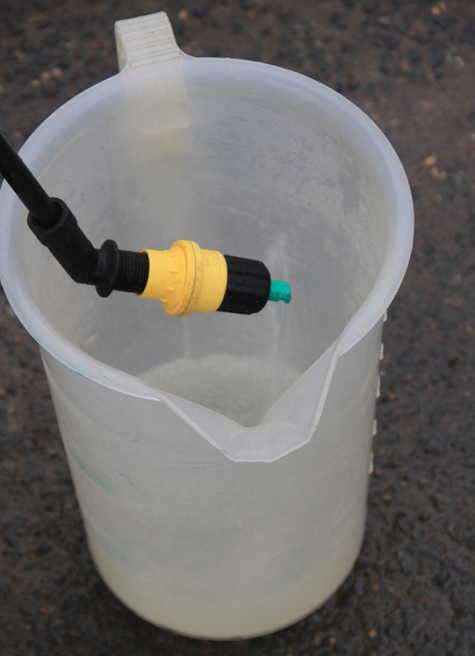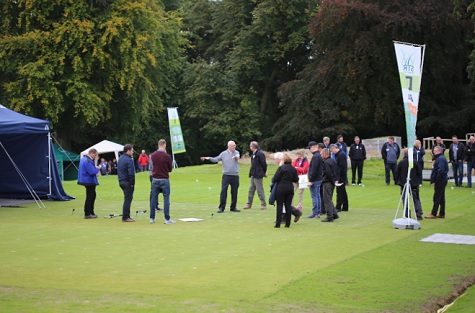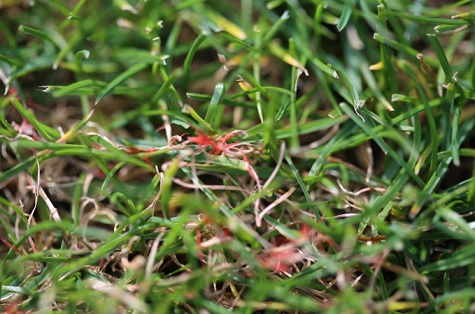In recent years we have seen a reduction in a number of chemical products (Pesticides) that where once in our armoury to control weeds pests and diseases. The use of Glysophate has also recently been in the news regarding its long-term use.
Pesticides are known as "plant protection products" and are used to control pests, weeds and diseases. There are many different types of plant protection products, common examples include: insecticides, fungicides, herbicides, molluscicides, and plant growth regulators.
These products can help ensure that we: have a good supply of safe, high quality, reasonably-priced, locally-grown foodstuffs; maintain the safety of our public spaces, industrial sites and transport infrastructure; manage flood risks; control invasive species; and provide access to high quality sporting facilities. They are also used by amateur gardeners. However, as these chemicals are designed to disrupt life processes, risks can be associated with their use.
The Health and Safety Executive aims to ensure that the plant protection products do not harm human health or have unacceptable effects on the environment.

They (HSE) do this principally by using the law to set strict conditions on the way these products can be used. They also work with other organisations to ensure the risk and impact of using them are understood and controlled appropriately.
The controls cover all parts of the 'life-cycle' of the product:
- Firstly, only authorised products can be marketed. In order to obtain an authorisation, applicants must provide data showing how the product will be used and the impact of that use. They assess the risks associated with different uses of products and set legally-enforceable conditions, setting out the way they must be stored, applied and, where appropriate disposed of.
- Secondly, they ensure products are used in a sustainable fashion. they use a combination of the law and provision of advice, sometimes developed by others, to ensure those responsible for using plant protection products think carefully about whether they need to be applied. And, if so, that they understand the potential risks and impacts and control them appropriately.
- Finally, they monitor the impact the chemicals are having to ensure that they do not harm human health or have unacceptable effects on the environment. Key controls here involve the setting of maximum residue levels for pesticides in foodstuffs and monitoring pesticide residues in food and drink.
Two independent expert committees and a stakeholder forum support and advise HSE and Ministers in these areas of work. Further information from the HSE can be seen by clicking here.
In our own sportsturf industry, we have over the years followed good practice set by a number of industry organisations such as the Amenity Forum, BASIS, Lantra, IOG and BIGGA.
Each and every one of us who work in the sportsturf industry should take the time to either get qualified and trained or attend some education courses on the use of pesticides. This will ensure you understand the law and use pesticides appropriately and safely.

I would recommend that any managers and practitioners who are responsible for using pesticides on their land should attend a number of events throughout the year to gain relevant continuing professional development (CPD) points to keep them qualified and suitably trained in the use of pesticides. These CPD points can be gained at many of our industry shows and seminars put on by various organisations and companies. In recent years both the IOG and BIGGA shows have laid on educational seminars that provide opportunities to gain these valuable CPD points along with STRI and the Amenity Forum who also generally hold annual conferences to promote best practice in the use of Plant Protection Products.

The STRI are holding an open day on the 19th & 20th September in Bingley, The Amenity Forum Conference 2018 will be held on the 9th October at Pirelli Stadium Burton, while the IOG Saltex will be held on the 31st October and 1st November. Finally the Harrogate based BTME run by BIGGA will be held on 22nd, 23rd and 24th January 2019. Make sure you attend one of these shows / events.
After such a hot / dry summer, most of us will be looking forward to some much-needed rain to help restore moisture deficits in our soils. Because of the hot weather many turf managers were unable to apply fertilisers or any plant protection products and are now waiting for some favourable wet weather to aid the application of these products.
After such a pleasant summer, we are now entering the autumn phase of our seasonal year, recently, we have seen evening air temperatures dropping dramatically, especially when we have clear, cloudless nights, resulting in heavy morning dews on our playing surfaces.
The combination of early morning dews, warm and wet weather and diminishing daylight hours increases the risk of fungal disease outbreaks. The right conditions to trigger these disease attacks are weakened or susceptible plants, a disease-producing organism (pathogen usually fungi) and weather conditions which favour the formation of fruiting bodies and spores (moist, mild wet conditions).
The majority of diseases will soon respond to our warm, autumn weather conditions. Relative humidity is important for spore germination and penetration of leaf tissues and constant wet conditions will allow the development and transportation of active fungi spores.
Most fungi grow well between 10°C - 40°C and function best at a pH range of 4-7pH. The first step in turfgrass disease management is identifying the true nature of the problem. Diseases are only one cause of turf loss, and disease control measures will do nothing to alleviate damage from other causes such as management, wear or plant stress. It is therefore essential to determine whether the problem is disease, and if so, which disease.
The three disease factors: susceptible grass / host, pathogen, and environment, provide the evidence for disease diagnosis. Symptoms are the expression of the susceptible grass to the disease and can take on a variety of forms.
Symptoms may appear on the leaves as small, circular, tan-coloured lesions surrounded by brown or purple borders (leaf spotting); as yellow, red, or tan blotches over most or all of the leaf blade (blighting); stunting; wilting; or as a brown or black rot on the crowns and roots. The appearance of these symptoms will also vary depending on the type of disease, the severity of the attack and the developing stage of the disease.
Early identification of the symptoms is essential for good disease management, however the best form of management is using preventive, cultural turf maintenance methods that reduce the ideal environmental factors that these diseases require for development, e.g. regular brushing/switching of the grass to remove excess moisture, regular aeration to allow gaseous exchange and water percolation.
In recent years we have seen the industry change from being reactive to being more preventative in our methods of dealing with outbreaks of disease. Rather than wait and then treat the disease once it appears, the industry is becoming more aligned to carrying out integrated pest management practices. IPM is an ecosystem-based strategy that focuses on long-term prevention of pests or their damage through a combination of techniques such as biological control, habitat manipulation, modification of cultural practices, and use of resistant varieties. Pesticides are used only after monitoring indicates they are needed according to established guidelines, and treatments are made with the goal of removing only the target organism. Pest control materials are selected and applied in a manner that minimises risks to human health, beneficial and nontarget organisms, and the environment.
In recent years we have also seen many advancements in weather phone apps that can forecast the likelihood of disease outbreaks based on local weather conditions. Both Syngenta and Bayer and a number of other pesticide suppliers now have their own dedicated weather forecasting apps that clearly denote effective times for applying their range of products to control and manage given disease outbreaks.
Other cultural methods to help reduce disease pressure would be removal of thatch, which harbours pathogens, by verti-cutting and end of season renovations, as well as checking mower blades are sharp to provide a precise cut of the leaf blade and reduce the potential for disease.

Identification of these diseases can sometimes be difficult in the early stages of attack. It's often only possible to recognise the type of disease when the fruiting bodies of the disease produce structures such as spores, mushrooms, or mycelium (small, thread-like filaments produced by fungi) that can be seen without the aid of a microscope. A good example of this is Red Thread (Laetisaria fuciformis) where the distinctive red filaments can be seen amongst the grass.
Site characteristics and turf management practices also have a large influence on disease management. Factors such as air movement, drainage, soil conditions, and the amount of sun or shade, slope, fertilisation and aeration programmes are important in influencing the development of turf diseases.
It is important to have identified the disease correctly, so that an appropriate fungicide can be selected. Using the wrong fungicide or wrong application rates can lead to a number of problems. Not only would it be a waste of time and money, the effect on the disease is likely to be negative and may well exacerbate the problem by making the disease more resilient to the active ingredient applied.
Turf grass is susceptible to disease attack when damaged or under stress, and when the soil surface remains wet during prolonged periods of wet cool weather. In severe infections, the fungus may penetrate as far as the crown, but will usually not kill the plant. If the plant does die, it is more likely from subsequent winter injury or another cause. Infected turf will recover when the plant becomes more active in the spring and is able to produce new healthy leaves, restoring its vigour and colour.
Fungicides can be divided into two broad categories: contact fungicides and systemic fungicides. The contact fungicides generally are applied to the leaf and stem surfaces of grass plants. These materials may or can be washed or mowed off easily, which implies that they often only have a short-term active durations, between 7-10 days. These fungicides are usually used to control foliar diseases and not diseases of the root and crown structures of the plant.
Contact fungicides can be used throughout the year.
Systemic fungicides have a different mode of action; the chemicals are absorbed and translocated within the plant's tissues. Thus, they are not as likely to be removed from the plant by rainfall and mowing. Therefore, they are active for longer periods and can protect plants for up to 4 weeks. Most systemic fungicides can control both foliar and root/crown diseases. Use of systemic fungicides during colder months is not advised, as the plant is either dormant of slow growing and will not rapidly uptake the fungicide, greatly reducing its effectiveness.
We all have a responsibility to care for our environment especially when considering the use of pesticides to manage our turf playing surfaces. Keeping ourselves updated and compliant is essential when applying any plant protection products.